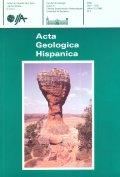Mineralogía de los materiales detríticos de la Fm. Escucha (Albiense inferior) en el distrito minero de Teruel (sector Suroriental de la Cordillera Ibérica)
Abstract
The present study focuses on the determination of the source areas of the Escucha Fm. (Albian) sediments in the Teruel Mining District (NE Spain). To this en4 we have carried out a detailed study of the heavy mineral fraction of the sandstone beds from this sedimentary unit at three stratigraphic successions at the Ariño-Oliete and Utrillas subbasins. The minerals found in the stratigraphic successions studied are in low proportions and a few mineral phases are present. Quartz is the dominant phase in the light mineral association, whereas potassium feldspars and plagioclase are in trace amounts. The opaque heavy minerals are hematite and goethite with minor amounts of pyrite. Finally, the transparent heavy minerals may be divided into the three following major associations: a) turmaline, zircon and rutile (resistant minerals); b) kyanite, staurolite and almandine (metamorphic association); and c) metamorphic mineral association from the Ctrillas sub-basin, characterised by very low heavy mineral proportions, and by the absence of one or various mineral phases from the association b.
The flow directions from paleochannels and the absence of metarnorphic minerals in the sandstone levels of the upper unit of the Escucha Fm at the northern areas point to the "Platuforma del Ebro" as a possihle source area The minerals with this origin, with variable morphoscopy, could proceed from sedimentary recycling The metamorphic assemblage found in the southern areas may proceed from the "Macizo Castellano", where gneiss and mica-schists are present. It is not possible to precisse exactly the age of the source areas of the detrital sediments of the Escucha Fm This is due to the fact that these may have been different through the basin evolution, and also to the evidence of recycling processes The middle and lower units of the Escucha Fm at Ariño and Oliete, where the workable coa1 seams are present, show a metamorphic assemblage which demonstrate the Paleozoic age of the source lands Consequently, the Triassic units could also supply detrital minerals to the delta system of the Escucha Fm. These results are consistent with the hypothesis of the Triassic origin of the sulphur enrichment of the coals from the Ariño-Oliete area The recycling of detrital sediments from the Escucha Fm or a different source lana could account for the proteciion of the Utrillas sub-basin against the Triassic sulphate supply, and consequently for the lower sulphur content of the coals from this area.


